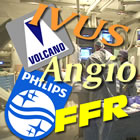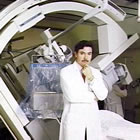 Rumors and theories about an acquisition of Volcano Corporation (NASDAQ: VOLC) had been circulating for quite some time: months, years even. The company seemed an obvious choice: it has an advanced intravascular ultrasound (IVUS) technology that leads the market, with Boston Scientific coming in second; it has a fractional flow reserve (FFR) wire that splits the market with St. Jude Medical; and recently Volcano gained FDA approval for its Instant Wave-Free Ratio (iFR) physiologic measurement product, a faster, cheaper potential alternative to FFR.
Rumors and theories about an acquisition of Volcano Corporation (NASDAQ: VOLC) had been circulating for quite some time: months, years even. The company seemed an obvious choice: it has an advanced intravascular ultrasound (IVUS) technology that leads the market, with Boston Scientific coming in second; it has a fractional flow reserve (FFR) wire that splits the market with St. Jude Medical; and recently Volcano gained FDA approval for its Instant Wave-Free Ratio (iFR) physiologic measurement product, a faster, cheaper potential alternative to FFR.
Yet, for all of its forward-looking technology, Volcano is a relatively small device company in comparison to its chief competitors, with less than $400 million in annual revenues. Boston Scientific has over $7 billion in revenues and St. Jude just under $6 billion, plus both have a broad product line that allows them to offer bundles (stents, valves, etc.) to hospitals, one reason Volcano’s market reach has been limited.
Another reason is the learning process that cardiologists, administrators and insurers have to go through in order to comprehend how Volcano’s intravascular guidance and measurement products can save money while improving patient outcomes. But more on that later.
So it was that in the late evening hours (Eastern Time) of Wednesday, December 17, the denouement to all the speculation was revealed: Royal Philips (NYSE: PHG; AEX: PHIA), based in Amsterdam, announced that it had entered into an agreement to acquire San Diego-based Volcano for $1.2 billion, or $18 per share, roughly five times Volcano’s annual gross profit.
It’s the Money: Too Much or Not Enough?
Immediately upon the news, Philips Chief Executive Officer Frans van Houten was questioned by reporters and stock analysts on the seemingly high price being paid, and he responded:
Frans van Houten
“The agreement to acquire Volcano significantly advances our strategy to become the leading systems integrator in image-guided therapies. Volcano’s impressive and unique product portfolio is highly complementary to our strong offering in live image-guidance solutions, creating an opportunity to accelerate the revenue growth for our image-guided therapy business to a high single-digit rate by 2017. Our combined sales forces will be able to capture immediate cross selling opportunities, while our joint R&D teams will be able to develop new solutions to address significant unmet needs in the minimally invasive treatment of cardiovascular diseases.”
In addition, there reportedly were other suitors moving in on Volcano, which had become an even more attractive acquisition due to a precipitous drop in its stock value, from a high of $24.62 per share in January down to $9.81 just a few weeks ago. This drop generated significant shareholder dissatisfaction, surfacing in a strong letter in September from Engaged Capital, calling for a radical change in direction and management. So Philips decided to act quickly and grab this asset before someone else did.
While some stock analysts may have felt Philips paid too much, quite the opposite was the case with some of Volcano’s shareholders who protested that the $18 per share was 27% below the peak stock price during the previous 52-weeks. And they responded with more than a half-dozen shareholder lawsuits.
These will play out over the next few months, but the current timeline calls for the acquisition to be completed in the first quarter of 2015. Philips will get all of Volcano’s assets, as well as its sales force which is embedded in catheterization laboratories around the world.
It’s the Technology: Angiography, Intravascular Guidance, and More
Philips has manufactured high resolution image intensifiers and constructed state-of-the-art catheterization laboratories for over half a century. These types of fluoroscopic systems have long been considered the gold standard for diagnosing coronary heart disease. The patient is placed on a table, a thin catheter is snaked from the femoral or radial artery to the heart, and a radio-opaque contrast dye is injected. The resulting video image shows the coronary circulation in motion: blockages can be seen, filling of the ventricles can be measured, the coronary anatomy is revealed. Sometimes, if a significant blockage is found, the diagnostic cardiac catheterization is converted to an angioplasty; sometimes the intervention is deferred for the moment; sometimes the disease is so advanced or complex that the patient is referred to open heart bypass surgery (CABG). In fact, as can be seen in the video at the end of this post, CABG would not have developed if it had not been for angiography.
But with the advent of percutaneous coronary interventions (a.k.a. PCI or angioplasty and stents), the black-and-white “shadow-gram,” as Dr. Gary Mintz calls angiography, is not enough. More information is needed about the interior of the artery, the actual diameter, the eccentricity of the plaque, and the flow characteristics around an identified blockage. These intravascular imaging technologies are what Volcano has specialized in, imaging the artery from the inside out. FFR, IVUS, as well as OCT (not a product of Volcano’s), can all add critical information to the angiogram produced in a cath lab, information that can change and refine treatment of the disease and improve outcomes for the patient.
And since this type of intravascular imaging is catheter-based and can only be performed during a catheterization, angiography and image-guided therapy are tied together. One problem has been the slow adoption of technologies, such as FFR, a measurement of blood flow which has been shown in several important trials to improve outcomes by targeting PCI more appropriately. Currently less than 15% of procedures utilize FFR or IVUS. Reimbursement and training has lagged, and it is hoped by some that Philips will have the heft to spread this beneficial technology to a wider audience. For example, in reply to our tweet about the impact of this acquisition, Dr. Justin Davies, co-inventor of the iFR technology, posted, “With x50 the Volcano market cap, I’m sure Philips will really accelerate and grow physiology!” and his colleague from Imperial Hospital in London, Dr. Suhk Nijjer, tweeted, “integrated systems combining x-Ray, IVUS, physiological Mapping & virtual-PCI.” Several years ago, I wrote an article, titled “FFR: Why Isn’t Everyone Using It?” Hopefully in the future that post will no longer be relevant.
Philips also produces a full range of other imaging modalities: echocardiography, CT, MRI and so on. The company’s software has even been used to experiment with Virtual PCI, where a CT image allows the cardiologist to run “what if” scenarios in deciding whether or not to stent a particular narrowing.
For more information on IVUS, FFR and other intravascular guidance technologies, visit Angioplasty.Org’s Intravascular Guidance Center, a section we created in 2007 to educate and advocate for these innovative modalities (Full disclosure: our Center has received support from Volcano Corporation.)
It’s the History: Philips and Interventional Cardiology Go “Way Back”
As I’ve written, Philips has been one of the major manufacturers of X-ray fluoroscopy imaging equipment and has a long experience in interventional cardiology, going back to the very beginnings of the specialty.
I remember when I began working in this field, fashioning the first live demonstration courses. I worked closely with Philips and its technicians to optimize the fluoroscopic video we transmitted to the audiences who were sitting in auditoriums, miles from the hospital. It was always gratifying, for example, to hear cardiologists in the audience query the operator about “the calcified plaque at the acute take-off of the circumflex artery,” knowing that they were seeing the same clear, sharp, accurate image that was being viewed in the cath lab. I did courses around North America and Europe and the majority of cath labs I worked in were Philips labs.

Andreas Gruentzig
That would include the innovative biplane labs at the San Francisco Heart Institute, where I worked with Richard Myler and Simon Stertzer, and at Emory University Hospital, where Andreas Gruentzig, the inventor of coronary angioplasty, did procedures and taught the first waves of interventional cardiologists how to do angioplasty safely and effectively. Coincidentally, Gruentzig’s right-hand man and lab tech in those days was Joe Brown who, until recently, was Vice President of Clinical Marketing and Global Sales at…Volcano Corporation! Small world.
Another “what goes around, comes around” citation: Gruentzig designed his original angioplasty balloon with a special lumen to measure arterial pressures around the blockage. This feature got eliminated when the need for thinner profile balloons trumped the need to see pressures. Gruentzig told me that he didn’t understand how doctors could perform these procedures without measuring the pressures. And now, Philips will soon have FFR, which is a more accurate version of Gruentzig’s device.
However, Philips’ involvement in diagnosing and treating coronary artery disease goes back even further than angioplasty. The lab in which Mason Sones first “discovered” selective coronary angiography in 1958 was a Philips imaging lab. I put “discovered” in quotes because, as you can see in the video below, his discovery was the result of a “happy accident.”
So, without further ado, here’s a clip about Sones, taken from a video on the history of interventional cardiology that I created for the ACC’s permanent exhibit at Heart House in Washington, DC.:
Leads to the Development of Bypass Surgery and Angioplasty (1:58)
© 2008, Venture Digital LLC • Music by Nell Shaw Cohen




